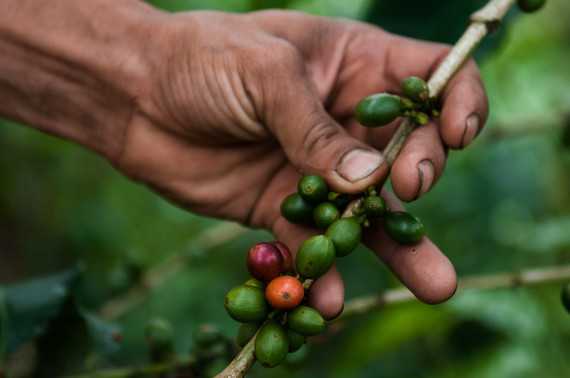LONDON, UK — Price movements for the group indicators of Arabica and Robusta coffees diverged in February 2019, shows the latest report from the International Coffee Organization. In February 2019, the ICO composite indicator fell by 0.9% to 100.67 US cents/lb, similar to the level in December 2018. The daily composite indicator reversed the gains made in January, falling from an average of 103.32 US cents/lb in the first week of February to a low of 97.44 US cents/lb on 26 February.
Prices for Brazilian Naturals and Colombian Milds registered decreases in February, while Other Milds remained unchanged, and Robusta prices increased 0.5% to 78.65 US cents/lb.
Shipments in the first four months of coffee year 2018/19 increased by 6.6% to 41.96 million bags, reflecting the ample supply of coffee on the international market. Exports of all types, except for Other Milds, increased in comparison to the first four months of 2017/18.
The difference in the availability of Colombian Mild coffee to Other Milds has resulted in a negative differential of 0.52 US cents/lb for February.
The monthly average of the ICO composite indicator fell by 0.9% to 100.67 US cents/lb in February 2019, which is slightly higher than the lowest monthly average of 100.61 US cents/lb reached in coffee year 2018/19 for December 2018. However, it is 27.5% below the 10-year average of 138.84 US cents/lb. Following on from the increase in January 2019, the daily composite indicator started above 100 US cents/lb, averaging 103.32 US cents/lb in the first week.
However, prices declined during the remainder of the month, reaching a low of 97.44 US cents/lb on 26 February. Sustained growth in exports during the first four months of coffee year 2018/19 compared to last year and prospects of a large off-year crop from Brazil for crop year 2019/20 are contributing to the low prices this coffee year.
Price movements for the group indicators diverged in February 2019. Prices for Brazilian Naturals fell by 2.8% to 100.06 US cents/lb, and prices for Colombian Milds decreased by 1% to 127.93 US cents/lb, while Other Milds remained unchanged at 128.45 US cents/lb.
In terms of differentials, the daily price of Other Milds frequently traded above Colombian Milds in February, resulting in a negative differential of 0.52 US cents/lb for the month. These price developments reflect the contrasting availability of Central American origins compared to Colombian Mild origins.
Prices for Robusta rose by 0.5% to 78.65 US cents/lb, which is the second consecutive month of increase. The decrease in Arabica prices coupled with a rise in Robusta prices narrowed the arbitrage between Arabica and Robusta coffees, as measured on the New York and London futures markets.
In February, the average arbitrage decreased by 10.7% to 33.60 US cents/lb. The last time arbitrage had reached this level was in April 2008, with a difference of just 32.75 US cent/lb between the New York and London futures prices. Intra-day volatility of the ICO composite indicator price remained unchanged at 6% as the intra-day volatility of Robusta decreased by one percentage point, while increasing for all Arabica indicators.
In January 2019, world coffee exports amounted to 11.06 million bags (184,314 metric tons), 2.6% higher than in January 2018. Shipments of Brazilian Naturals, Colombian Milds and Robusta rose by 12.8% to 3.51 million bags, 14.5% to 1.31 million bags and 3.2% to 4.43 million bags, respectively. However, exports of Other Milds fell by 18.9% to 1.81 million bags.
In the first four months of 2018/19, total exports grew by 6.6% to 41.96 million bags. Exports of all types, except for Other Milds, increased compared to the first four months of 2017/18. Shipments of Brazilian Naturals rose by 19% to 15.21 million bags, while Colombian Milds grew by 7.3% to 5.28 million bags. Robusta exports increased by 4.1% to 14.7 million bags. In contrast, shipments of Other Milds fell by 10.1% to 6.77 million bags.
Exports from Africa rose by 1.2% to 948,870 bags in January 2019 and by 5.8% to 4 million bags in the first four months of coffee year 2018/19. Uganda is the largest exporter in the region, though its shipments declined by 8.8% to 1.47 million bags in October 2018 to January 2019.
Ethiopia is the region’s largest producer, but second largest exporter due to significant domestic consumption of coffee. In the first four months of 2018/19, its exports decreased by 8.9% to 1 million bags. However, growth in exports from Côte d’Ivoire and Tanzania have offset these declines.
Shipments from Côte d’Ivoire more than doubled in the first four months of 2018/19, amounting to 502,623 bags. Exports from Tanzania increased by 55.7% to 399,540 bags. Coffee production in Africa is estimated 1.8% higher at 17.8 million bags in 2018/19.
Ethiopia’s production is estimated to remain stable at 7.5 million bags, while Uganda’s production is estimated to rise 2.2% to 4.9 million bags. Output from Côte d’Ivoire and Tanzania is estimated at 1.6 million bags and 827,000 bags, respectively.
Shipments from Asia & Oceania decreased by 0.9% to 4.17 million bags in January 2019 and by 2.8% to 13.21 million bags in the first four months of coffee year 2018/19. Vietnam is the region’s largest exporter and the world’s second largest.
Its exports in the first four months of 2018/19 are estimated 6.1% higher at 9.5 million bags. However, shipments from Indonesia and India decreased by 27.6% to 1.7 million and by 19% to 1.54 million bags, respectively. Papua New Guinea is the region’s fourth largest exporter, and its shipments increased by 33.4% to 317,030 bags.
Regional output is estimated at 48.01 million bags, 2.1% lower than last year. Vietnam’s production is estimated to decline by 3.4% to 29.5 million bags due to poor weather, while Indonesia’s output is estimated 5.7% higher at 11.1 million bags.
India’s output is estimated to decline 10.5% to 5.2 million bags as a result of the flooding at the end of last summer. However, the growth in Papua New Guinea’s exports is supported by a larger harvest in 2018/19, which increased by 6.5% to 817,000 bags.
Exports from Central America & Mexico fell by 23.7% to 1.18 million bags in January 2019 and by 13.7% to 3.15 million bags in the first four months of coffee year 2018/19. Honduras is the region’s largest exporter and the world’s 8th largest.
In October 2018 to January 2019, it shipped 1.19 million bags, a decrease of 22.4% compared to last year. Exports from Mexico are estimated to have decreased by 7.7% to 850,000 bags. Shipments from Costa Rica fell by 5.3% to 148,068 million bags, following three consecutive years of growth.
In contrast, El Salvador’s exports have increased by 15.9% to 81,298 bags. Output in the region is estimated at 21.72 million bags, 0.5% lower than last year. Production in Honduras is estimated down 1.5% to 7.45 million bags, while output in Mexico, is estimated to rise by 2.5% to 4.5 million bags. Costa Rica’s production is estimated to grow by 34,000 bags to 1.6 million bags, while El Salvador’s output is unchanged from last year.
Shipments from South America grew by 16.4% to 4.76 million bags in January 2019 and by 17.9% to 21.6 million bags in the first four months of coffee year 2018/19. Brazil’s exports are 26.8% higher at 14.73 million bags in October 2018 to January 2019.
However, shipments are slowing as Brazil nears the end of its 2018/19 crop year with exports reaching 3.29 million bags in January 2019 compared to an average of 3.81 million bags in October to December 2018. Colombia’s exports amounted to 4.79 million bags in the first four months of coffee year 2018/19, 5% higher than last year.
Peru’s shipments rose by 1.3% to 1.92 million bags. Production in South America, which accounts for 47.7% of global output in 2018/19, is estimated to grow 4.3% to 79.94 million bags.
Brazil’s production in coffee year 2018/19 amounted to a record 60.1 million bags, which has contributed to the oversupply of coffee this year. Colombia is estimated to harvest 14.2 million bags, an increase of 2.7% compared to last year, and Peru’s output is estimated to rise by 1.7% to 4.36 million bags.

















